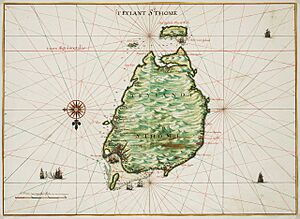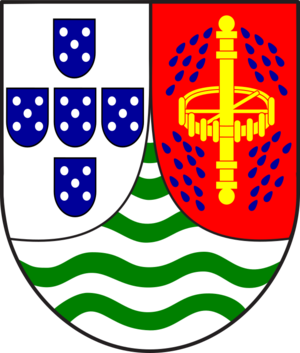History of São Tomé and Príncipe facts for kids
The islands of São Tomé and Príncipe are located off the coast of Africa. When Portuguese explorers first arrived between 1469 and 1471, no one lived there. Explorers like João de Santarém and Pêro Escobar found the islands. The Portuguese thought these islands would be good places for trading posts.
Contents
Portuguese Rule in São Tomé and Príncipe
The first lasting settlement on São Tomé began in 1493. Álvaro Caminha received land from the Portuguese king to start a colony. Príncipe was settled in a similar way in 1500. It was hard to get people to move there at first. Many early settlers were people sent from Portugal, including Jewish people.
Sugar Plantations and Slavery
Over time, these settlers found the rich volcanic soil was great for farming. They started growing sugar cane. Growing sugar needed a lot of workers. So, the Portuguese began bringing many enslaved people from mainland Africa. By the mid-1500s, these islands became Africa's top sugar exporter. The Portuguese crown took direct control of São Tomé in 1522 and Príncipe in 1573.
However, other sugar colonies in the Americas became more successful. It was also hard to control the large enslaved population. Portugal did not have many resources to help. In 1641, the Dutch took over São Tomé for seven years. They destroyed many sugar mills. Because of this, sugar farming slowly stopped over the next 100 years. By the mid-1600s, São Tomé's economy changed. It became a stopover point for ships involved in the slave trade. These ships traveled between West Africa and the Americas.
New Crops and Unfair Labor
In the early 1800s, two new important crops were brought in: coffee and cocoa. The rich soil was perfect for these new crops. Soon, large farms called roças covered almost all the good land. These farms were owned by Portuguese companies or people who lived far away. By 1908, São Tomé was the world's biggest cocoa producer. Cocoa is still the country's most important crop today.
The roças system gave farm managers a lot of power. This led to unfair treatment of African farm workers. Portugal officially ended slavery in 1876. But forced labor, where people were made to work for very little pay, still continued. In the early 1900s, there was a big international argument. People said that workers from Angola were forced to work in bad conditions. During the Great Depression, workers were treated even worse.
Worker Protests and the Batepá Massacre
Workers continued to be unhappy and protested often in the 1900s. This led to riots in 1953. Several hundred African workers were killed in a fight with their Portuguese rulers. This event is called the "Batepá Massacre." It is a very important part of the islands' history. The government still remembers its anniversary each year.
During the Nigerian Civil War (1967–1970), São Tomé was a main base. It helped with the Biafran airlift. This airlift was a huge effort to bring food and medicine to eastern Nigeria. It was the largest civilian airlift ever at that time. It is believed to have saved over a million lives.
Path to Independence
By the late 1950s, many African countries wanted to be free. A small group of São Toméans formed the Movement for the Liberation of São Tomé and Príncipe (MLSTP). This group set up its base in nearby Gabon. The movement grew stronger in the 1960s. Things moved quickly after Portugal's government changed in April 1974. The new Portuguese leaders wanted to let go of their colonies.
In November 1974, MLSTP leaders met with Portuguese officials. They agreed on how to transfer power. After a short time with a temporary government, São Tomé and Príncipe became independent on July 12, 1975. The first president was Manuel Pinto da Costa, who was the MLSTP Secretary General.
São Tomé and Príncipe Today
In 1990, São Tomé became one of the first African countries to become more democratic. They changed their constitution to allow other political parties. Elections in 1991 were peaceful, fair, and open. Miguel Trovoada, a former prime minister, returned from exile. He ran as an independent candidate and was elected president. Trovoada was re-elected in 1996.
The Democratic Convergence Party – Reflection Group (PCD) won most seats in the National Assembly of São Tomé and Príncipe. The MLSTP became an important minority party. Local elections happened in late 1992. The MLSTP won most seats in five of the seven regional councils. In early elections in October 1994, the MLSTP won the most seats in the Assembly. They won a clear majority in November 1998. São Tomé's government now works with many political parties.
Recent Political Events
Presidential elections were held in July 2001. Fradique de Menezes, supported by the Independent Democratic Action party, won and became president on September 3. Parliamentary elections were in March 2002. For the next four years, several short-lived governments led by opposition parties were formed.
In July 2003, the army took power for one week. They said they were unhappy about corruption. They also worried that future oil money would not be shared fairly. An agreement was made, and President de Menezes returned to office.
In March 2006, a group of parties supporting the president won enough seats. They formed a new government. On July 30, 2006, Presidential elections were held. Fradique de Menezes easily won a second five-year term. He defeated Patrice Trovoada and Nilo Guimarães. Local elections, the first since 1992, took place on August 27, 2006. Members of the ruling group won most of these elections.
Evaristo Carvalho became President of São Tomé and Príncipe after the 2016 elections. He defeated the previous president, Manuel Pinto da Costa. President Carvalho was also the Vice President of the Independent Democratic Action (ADI) party. Patrice Emery Trovoada, the ADI leader, was Prime Minister from 2014 to 2018. In December 2018, Jorge Bom Jesus became Prime Minister. He leads the Movimento de Libertação de São Tomé e Príncipe-Partido Social Democráta (MLSTP-PSD).
In September 2021, Carlos Vila Nova won the presidential election. He was the candidate for the Independent Democratic Action (ADI) party. The president mostly has a ceremonial role. The Prime Minister holds most of the political power. In September 2022, the Independent Democratic Action (ADI) party won the election. This party is led by former Prime Minister Patrice Trovoada. They won against the ruling MLSTP/PSD party of Prime Minister Jorge Bom Jesus. On November 11, 2022, Patrice Trovoada was named Prime Minister by President Carlos Vila Nova. On November 25, 2022, there was a failed coup attempt.
See also
 In Spanish: Historia de Santo Tomé y Príncipe para niños
In Spanish: Historia de Santo Tomé y Príncipe para niños
- History of Africa
- Politics of São Tomé and Príncipe
- List of heads of state of São Tomé and Príncipe
- List of heads of government of São Tomé and Príncipe
- Religion in São Tomé and Príncipe



